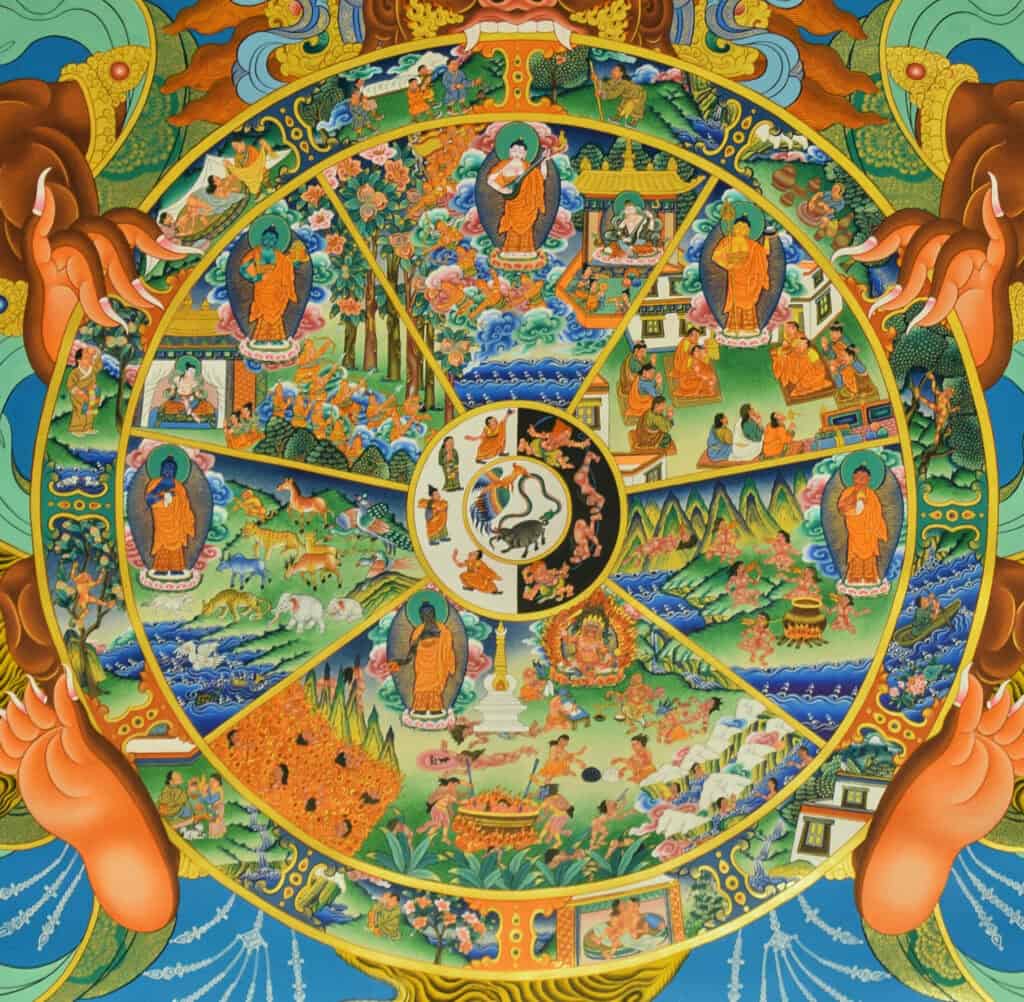The 12 Links of Dependent Origination is a fundamental concept in Buddhist philosophy that explains the nature of suffering and the cycle of existence. It is a complex doctrine that describes the interdependent nature of all phenomena and the causes and conditions that give rise to them. The 12 Links of Dependent Origination is a key teaching in Buddhism that is used to explain the nature of suffering and the path to liberation.
Understanding Dependent Origination is essential to understanding the Buddhist view of the world and the nature of existence. The doctrine of Dependent Origination describes the interdependent nature of all things and how everything arises in dependence upon conditions. The 12 Links of Dependent Origination is a detailed explanation of this doctrine, and it provides a framework for understanding the causes and conditions that give rise to suffering and the path to liberation.
The 12 Links of Dependent Origination is a complex concept that requires careful study and reflection. It is a key teaching in Buddhism that is used to explain the nature of suffering and the path to liberation. By understanding the nature of Dependent Origination, one can gain insight into the causes of suffering and the path to liberation.
Key Takeaways
- The 12 Links of Dependent Origination is a key teaching in Buddhism that explains the nature of suffering and the path to liberation.
- Understanding Dependent Origination is essential to understanding the Buddhist view of the world and the nature of existence.
- By understanding the nature of Dependent Origination, one can gain insight into the causes of suffering and the path to liberation.
Understanding Dependent Origination
Dependent origination, also known as “pratītyasamutpāda” in Buddhism, is a fundamental principle of Buddhist philosophy. It explains the interdependence and interconnectedness of all phenomena, including the causes and conditions that lead to suffering and the path to enlightenment.
At its core, dependent origination is the principle that all phenomena arise in dependence upon other phenomena. The Buddha taught that everything in the world is constantly changing and that nothing exists in isolation. Instead, everything is interconnected and arises in dependence upon a complex web of causes and conditions.
The 12 links of dependent origination describe this process of causation and interdependence. These links describe how ignorance leads to suffering and how the cessation of ignorance leads to the cessation of suffering. The links are:
- Ignorance
- Volitional activities
- Consciousness
- Name and form
- Six sense bases
- Contact
- Feeling
- Craving
- Clinging
- Becoming
- Birth
- Aging and death
Each link arises in dependence upon the previous link, and each link conditions the arising of the subsequent link.
Understanding dependent origination is crucial to understanding the nature of suffering and the path to enlightenment. By understanding the causes and conditions that lead to suffering, practitioners can work to eliminate those causes and conditions and achieve liberation.
The 12 Links Explained
The 12 Links of Dependent Origination, also known as the 12 Nidanas, describe the process of cause and effect that leads to suffering, death, and rebirth in Buddhist philosophy. These links form a chain that begins with ignorance and ends with old age and death. Understanding the 12 Links is essential to understanding the Buddhist concept of suffering and the path to liberation from it.
Ignorance
The first link in the chain is ignorance. This refers to the ignorance of the true nature of reality, which leads to delusion and confusion. Ignorance is the root of all suffering, and it is only by overcoming ignorance that one can attain liberation.
Formation
The second link is formation, which refers to volitional formation or the formation of karma. This link describes the process of creating karma through thoughts, words, and actions. Karma is the cause of rebirth and determines the nature of one’s future existence.
Consciousness
The third link is consciousness, which refers to the awareness of sensory experience. Consciousness arises when the sense organs come into contact with their objects. Consciousness is impermanent and constantly changing, and it is the basis for the rest of the links.
Name and Form
The fourth link is name and form, which refers to the mental and physical aspects of existence. Name refers to the mental aspects, such as thoughts and emotions, while form refers to the physical aspects, such as the body and the sense organs.
Six Senses
The fifth link is the six senses, which refer to the sense organs and their objects. The six senses are the eye, ear, nose, tongue, body, and mind. The six senses are the basis for sensory experience and the source of pleasure and pain.
Contact
The sixth link is contact, which refers to the meeting of the sense organs with their objects. Contact gives rise to feeling and is the basis for the experience of pleasure and pain.
Feeling
The seventh link is feeling, which refers to the experience of pleasure, pain, or neutrality that arises from contact. Feeling is impermanent and constantly changing, and it is the basis for craving.
Craving
The eighth link is craving, which refers to the desire for pleasure and the aversion to pain. Craving arises from feeling and is the cause of suffering.
Grasping
The ninth link is grasping, which refers to the clinging to pleasure and the aversion to pain. Grasping is the result of craving and is the cause of suffering.
Becoming
The tenth link is becoming, which refers to the process of rebirth. Becoming is the result of grasping and is the cause of the continuation of suffering.
Birth
The eleventh link is birth, which refers to the physical birth of an individual. Birth is the result of becoming and is the cause of old age and death.
Old Age and Death
The twelfth and final link is old age and death, which refers to the process of aging and dying. Old age and death are the result of birth and the cause of rebirth, and the continuation of suffering.
In summary, the 12 Links of Dependent Origination describe the process of cause and effect that leads to suffering, death, and rebirth. Each link is dependent on the previous link, and the chain can only be broken by overcoming ignorance and attaining liberation. Understanding the 12 Links is essential to understanding the Buddhist concept of suffering and the path to liberation from it.
Understanding Karma and Suffering
The 12 Links of Dependent Origination show that suffering is not random but caused by our own actions. Understanding the nature of cause and effect allows us to take responsibility for our actions and avoid creating negative karma.
The Wheel of Life, also known as the Bhavacakra, is a symbolic representation of the 12 Links of Dependent Origination. It shows how beings are trapped in the cycle of suffering and how they can escape by following the path to enlightenment.
Understanding the nature of karma and cause and effect is essential in breaking the cycle of suffering and achieving liberation from samsara.
The Path to Liberation
The path to liberation begins with the recognition of the Four Noble Truths, which are the foundation of Buddhist philosophy. The first Noble Truth is the truth of suffering, which acknowledges that all beings experience suffering in some form. The second Noble Truth is the truth of the cause of suffering, which is attachment and craving. The third Noble Truth is the truth of the cessation of suffering, which is achieved through the elimination of attachment and craving. The fourth Noble Truth is the truth of the path to the cessation of suffering, which is the Eightfold Path.
The Eightfold Path is a set of practices that lead to the cessation of suffering and the attainment of enlightenment. These practices include right understanding, right intention, right speech, right action, right livelihood, right effort, right mindfulness, and right concentration.
Mindfulness is a key component of the Eightfold Path and involves being aware of one’s thoughts, feelings, and sensations in the present moment. Through mindfulness, one can develop wisdom and insight into the nature of reality and the true causes of suffering.
The Buddha taught that the path to liberation requires the cultivation of wisdom, morality, and concentration. Wisdom involves understanding the true nature of reality, while morality involves living in accordance with the principles of right conduct. Concentration involves developing the ability to focus the mind and cultivate inner peace.
Frequently Asked Questions
What is the meaning of the twelve-linked chain of causation in Buddhism?
The twelve-linked chain of causation, also known as the law of dependent origination, is a fundamental concept in Buddhism. It explains the process of how suffering arises, and how it can be ended. The twelve links represent a cycle of cause and effect, where each link arises due to the previous one, and leads to the next.
How does the law of dependent origination relate to the concept of suffering in Buddhism?
The law of dependent origination is closely related to the concept of suffering in Buddhism. According to the Buddha, suffering arises due to craving and attachment, which in turn arise due to ignorance. The twelve links represent the causes and conditions that lead to suffering, and by understanding and breaking this cycle, one can end suffering.
Can you explain the chain of dependent origination in simple terms?
The chain of dependent origination can be explained in simple terms as follows: ignorance leads to volitional formations, which lead to consciousness, which leads to name and form, which leads to the six sense bases, which lead to contact, which leads to feeling, which leads to craving, which leads to clinging, which leads to becoming, which leads to birth, which ultimately leads to aging and death.












